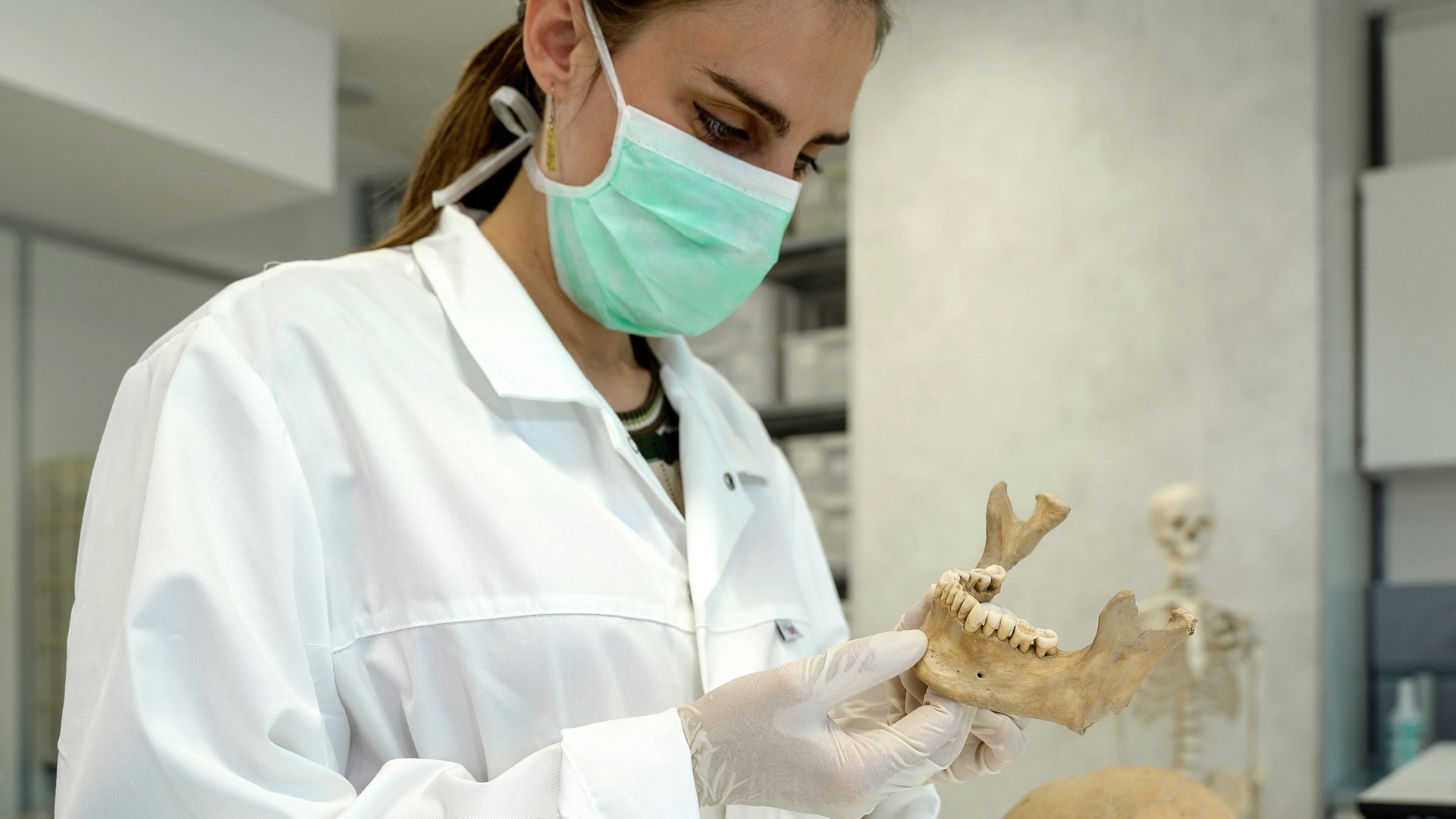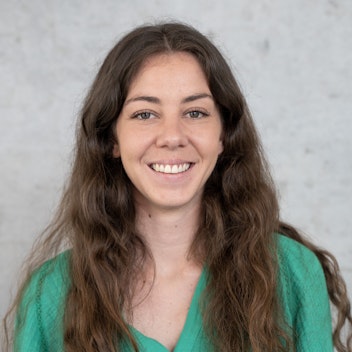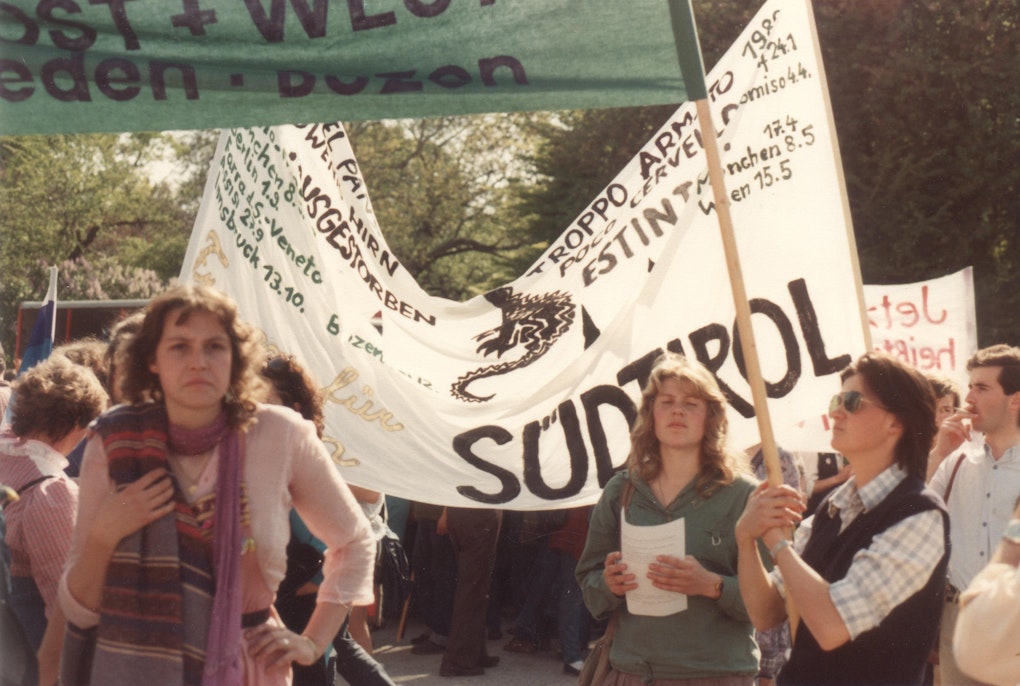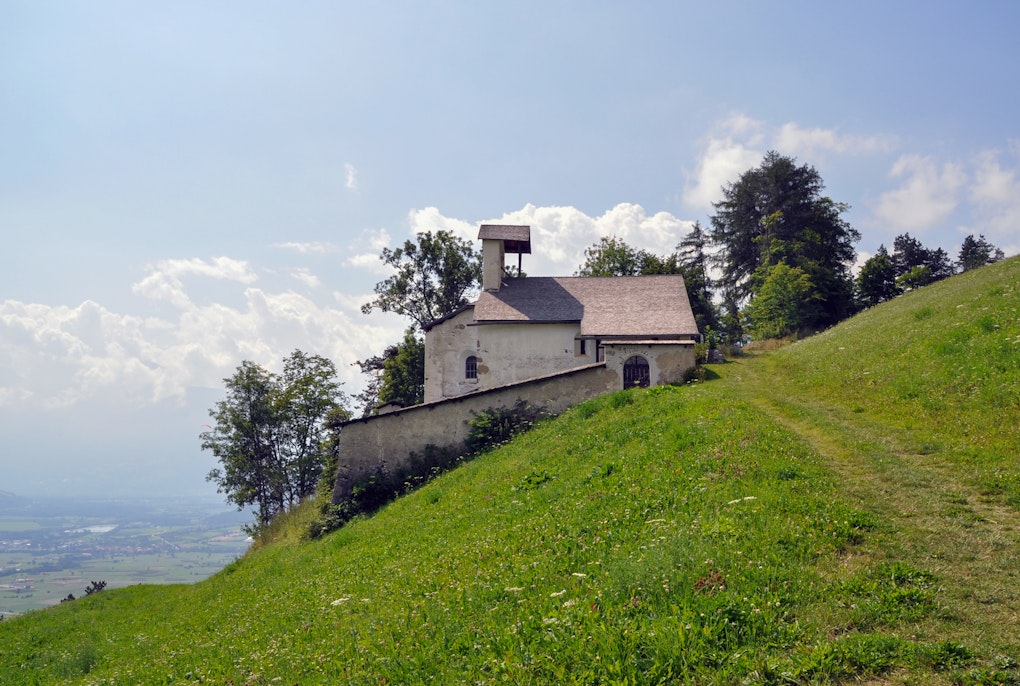magazine_ Feature
Methanobreviwhat?
Newly published study on ancient skeletal remains reveals previously unknown species of microorganisms.
Analysis of dental calculus on the mandibular teeth of the early individual in South Tyrol, Italy. Alice Paladin/Eurac Research
Photo: Eurac Research
A study on 20 ancient human skeletal remains from Trentino-South Tyrol, Italy reveals new insights into the diversity of human oral microbiome.
When one thinks of discoveries in the archaeological world it’s difficult to not imagine Indiana Jones swinging from vines or Lara Croft sliding under pyramid doors to avoid ancient booby traps however, what gets the real cognoscenti buzzing couldn’t be further removed from this picture. So, you may ask, what is all the excitement about? The answer, of all things, is dental plaque. Solidified plaque also known as calculus to be precise. You know, the stuff we go to the hygienist to get removed.
Except in this case, the calculus in question comes from 20 ancient human skeletal remains originating from Trentino-South Tyrol, Italy and dating from the Neolithic (6000-3500 BCE) to the Early Middle Ages (400-1000 CE). And the reason this calculus is being discussed in archaeological circles around the world is because of thea microorganisms microbiome that used to be housed within it while the individual was alive. The microbiome microorganism to which I refer is called Methanobrevibacter. Sound familiar? Don’t worry it didn’t to me either.
Methanobrevibacter is an archaeal or, single celled species organism that lives without oxygen i.e., in anaerobic conditions, and also produces methane and a microorganism which is also common in our bodies today. So, now that we know what Methanobrevibacter is, I suppose you want to know how it relates to archaeology (and skeletons). Well, dental calculus preserves many types of microfossils and biomolecules, including microbial and host DNA, and therefore ancient calculus is an important source of information about our oral microbiome and its development.
Through the analysis of the tartar calculus of the aforementioned human skeletal remains, a team of researchers from Eurac Research and the University of Trento discovered two previously unknown types of Methanobrevibacter. Thanks to the application of a method not yet established in mummy research called de novo sequencing metagenome assembly, the research group also revealed that over a period of 50,000 years, the diversity of this organism in our mouths has declined sharply in recent centuries.
The remains in question range from about 5000 to 1,000 years old and were discovered at several burial sites in Trentino and South Tyrol. Of the 20 individuals examined, 18 exhibited oral diseases, especially periodontitis, a bacterial inflammation of the gums. In the past, people didn’t brush their teeth like today, let alone visit a hygienist and, as a result, deposits of large amounts of tartar with well-preserved DNA have survived the archaeological record.
Even though the word hygiene has been part of our vernacular since the times of the Ancient Greeks, the word comes from Hygeia, the Greek goddess of health, who was the daughter of Aesculapius, the god of medicine, ancient oral health practices were definitely not ones we are familiar with today. In fact, if Pliny the Elder’s toothache remedies from the first century AD are to be accepted as typical ancient practice, one can easily imagine how oral disease could have flourished.
“…it may be cured by using the ashes of the head of a dog that has died in a state of madness. The head, however, must be burnt without the flesh, and the ashes injected with oil of Cyprus into the ear on the side affected.” If all else fails, “earthworms, boiled in oil and injected into the ear on the side affected, afford considerable relief.” Pliny the Elder Natural Histories Book XXVIII
If all else fails, “earthworms, boiled in oil and injected into the ear on the side affected, afford considerable relief.”
Pliny the Elder
Skip forward to Medieval Britain, a few hundred years later the population had begun various habits to keep their teeth clean. This included rinsing your mouth out with water, or a mixture of vinegar and mint. Bay leaves soaked in orange flower water were also used, and the teeth would often be rubbed with a clean cloth too – however the samples analysed for this particular study, despite being spread out in terms of time all demonstrated one thing in common. Substantial amounts of plaque calculus and although some of our ancient ancestors may have had good oral hygiene – the remains sampled didn’t. So although conclusions can be drawn about the profusion of microorganisms, they can’t be generalised to cultural practices.
Following an initial analysis, the research group focused primarily on the main representative that was present in abundance and in great diversity among the bacteria microorganisms in the plaque calculus - our by now familiar friend… Methanobrevibacter. In order to investigate the diversity of this genus, the team decided on a new methodological approach, namely, to decode the entire genomes of the existing variants of Methanobrevibacter found in the calculus. In addition to the skeletal remains from Trentino-South Tyrol, the researchers also worked through 82 tartar samples from previously published studies - including one from a Neanderthal find - analyzing in total, 102 tartar samples spanning a period of over 50,000 years, eight countries and three continents.
The in-depth study of the ancient oral pathogens was led by the Eurac Research Institute of Mummy Studies very own Lena Granehäll in close collaboration with Nicola Segata and his team, at the Department of Cellular, Computational, and Integrative Biology (CIBIO) at the University of Trento. Using next generation computational metagenomic tools to profile microbiomes at increased resolution and perform large-scale comparative genomics on uncharacterized microbes Nicola and the CIBIO team isolate and catalogue the topography of the human microbiome – all the microorganisms in and on our bodies. During the course of dedicated years of research, Nicola and team have catalogued the microorganisms of the intestinal microbiome and in doing so, also discovered many species of bacteria that were previously unknown
"It was an 'aha' moment when we then realised that we had discovered two completely new species of Methanobrevibacter and were thus also able to reveal a genetic diversity of this microorganism that was previously unknown."
Lena Granehäll
"It was the first time we applied the method so consistently and with such breadth, and we didn't know what we would come across," explains the microbiologist and lead author of the study. "It was an 'aha' moment when we then realised that we had discovered two completely new species of Methanobrevibacter and were thus also able to reveal a genetic diversity of this microorganism that was previously unknown. No geographical patterns are discernible here; all species occurred in the samples in Europe as well as Asia and America."
However, one thing was discernable. The research team observed a clear pattern in terms of time. While the newly discovered species turned out to be "older" types of Methanobrevibacter and were consistently present in the oldest tartar samples up to the Late Middle Ages, they were replaced by a single species from that time onwards. In the samples from the Middle Ages onwards, the older representatives are completely absent.
For the calculus study, Segata and his team analyzed the DNA that had been extracted from the ancient samples by the Eurac Research team. "An important part of the work in this study was to separate old DNA from modern DNA after sequencing the genetic material. Because old samples like these remained in a non-sterile environment for many many years, they contain a lot of microbes and DNA which do not belong to the original oral microbiome," explains Nicola Segata. "Analysing old samples is a bit like studying genetic fossils and in this way, we can reconstruct the evolution of particular microorganisms. As in this case, we can also discover new species of microorganisms that we may have lost over time due to our modern lifestyle," Segata concludes.
"Analysing old samples is a bit like studying genetic fossils and in this way, we can reconstruct the evolution of particular microorganisms. As in this case, we can also discover new species of microorganisms that we may have lost over time due to our modern lifestyle."
"Genetically, nothing has changed in humans over the last 5,000 years; but the same cannot be said for our fellow bacteria"
Frank Maixner
"As our study shows, there seems to have been a loss of species of this microorganism in our mouths. It goes hand in hand with what we have also already seen in stomach samples, namely, 5,000 years ago, there was a diversity of bacteria that decreased significantly over a very short period of time," underlines Eurac Research microbiologist Frank Maixner. "Genetically, nothing has changed in humans over the last 5,000 years; but the same cannot be said for our fellow bacteria which have been exposed to greater influences: we see that industrialisation, new therapies, changes in medicine and in our diet, have all impacted the composition of our bacterial diversity, not only in the mouth, but all the way to the stomach and intestines too."
The results of the study have now been published in the renowned journal "Microbiome". https://microbiomejournal.biomedcentral.com/articles/10.1186/s40168-021-01132-8







